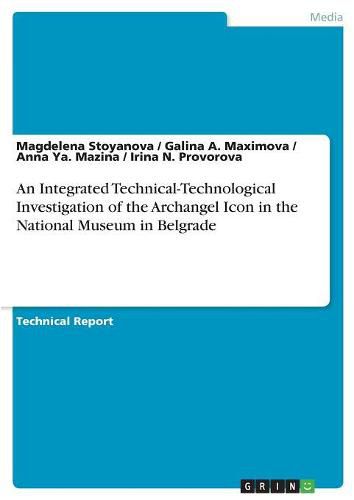Readings Newsletter
Become a Readings Member to make your shopping experience even easier.
Sign in or sign up for free!
You’re not far away from qualifying for FREE standard shipping within Australia
You’ve qualified for FREE standard shipping within Australia
The cart is loading…






Technical Report from the year 2016 in the subject Art - Overall Considerations, grade: A COST Case Study, course: Cost Action TD1201 Working Group Meetings; 5th international Culture Forum St. Peterburg December 2016, language: English, abstract: This complex investigation by European and Russian experts was carried out for the purpose of solving the question of the authorship and date of the Archangel icon kept in the National Museum in Belgrade and attributed to the 15th c Novgorod school. It had also the task to explore the possibilities and limits of non-destructive methods in identification, dating and authentication of icon painting, as well as of other types of historic easel painting. In addition to the various technological methods, the research project included assessment of the outcomes on base of additional information from databases accumulated by leading research and restoration centers in Russia and Eastern Europe. The authors’ purpose was to demonstrate that actually the conditions for authenticity controls are easily available, and that they can be realized at an enough competitively level, making better use of already accumulated experience and using a more common technological base. Particularly important is to underline that tools for efficient non-contact investigation of artefacts are not exclusively the optical techniques and the utilized instruments for themselves, but also the way in which the various data they produce have been assessed. For to transform these informational resources in real knowledge, their mass storage and interactive art historical, technical and technological assessment is of fundamental importance. The non-destructive methods and techniques used included optical microscopy, macro photography in VIS/raking light, stereo microscopy, ultraviolet luminescence/fluorescence, infrared reflectography, X-ray, EDXRFS, computer tomography, anatomical analysis of wood, micro chemical analysis, and were followed by a compar
$9.00 standard shipping within Australia
FREE standard shipping within Australia for orders over $100.00
Express & International shipping calculated at checkout
Technical Report from the year 2016 in the subject Art - Overall Considerations, grade: A COST Case Study, course: Cost Action TD1201 Working Group Meetings; 5th international Culture Forum St. Peterburg December 2016, language: English, abstract: This complex investigation by European and Russian experts was carried out for the purpose of solving the question of the authorship and date of the Archangel icon kept in the National Museum in Belgrade and attributed to the 15th c Novgorod school. It had also the task to explore the possibilities and limits of non-destructive methods in identification, dating and authentication of icon painting, as well as of other types of historic easel painting. In addition to the various technological methods, the research project included assessment of the outcomes on base of additional information from databases accumulated by leading research and restoration centers in Russia and Eastern Europe. The authors’ purpose was to demonstrate that actually the conditions for authenticity controls are easily available, and that they can be realized at an enough competitively level, making better use of already accumulated experience and using a more common technological base. Particularly important is to underline that tools for efficient non-contact investigation of artefacts are not exclusively the optical techniques and the utilized instruments for themselves, but also the way in which the various data they produce have been assessed. For to transform these informational resources in real knowledge, their mass storage and interactive art historical, technical and technological assessment is of fundamental importance. The non-destructive methods and techniques used included optical microscopy, macro photography in VIS/raking light, stereo microscopy, ultraviolet luminescence/fluorescence, infrared reflectography, X-ray, EDXRFS, computer tomography, anatomical analysis of wood, micro chemical analysis, and were followed by a compar